25 Evidence-Based Benefits of Papaya
What is Papaya
Originating in Central America, the papaya, Carica papaya, is a large herbaceous plant resembling a tree, although it is not woody (1).
Interestingly, some historians believe that the papaya may represent a fusion of two species of Carica that were once native to the lands of Central America and Mexico.
As of now, however, the papaya fruit is predominantly cultivated in most tropical regions and not limited to just Central America and Mexico.
Generally grown from their small seeds, papayas develop very rapidly under favorable conditions, and their fruit is usually produced before the end of their first year of growth.
The plants themselves do not have an extremely long lifespan, as most papaya plants live to about five years old, with some living longer than five (2).
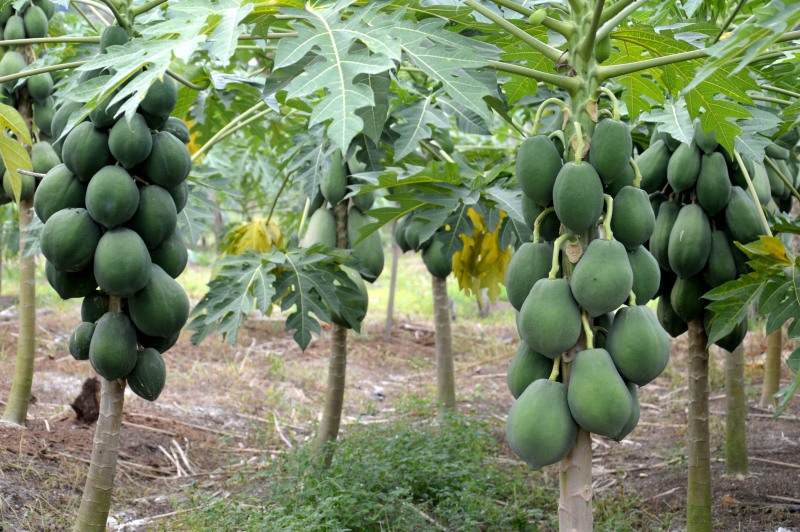
Etymology of the Word
Because of its widespread prevalence, the papaya actually has many different names that it goes by, from pawpaw in Europe and Australia to fruita bomba in Cuba to papaya in France and finally to mamao in Brazil.
Despite its many names, the papaya is a universal and extremely versatile fruit used around the world.
The most common form of the fruit is called a “solo,” which is the Hawaiian papaya.
This specific variety is shaped like a pear, measures about six inches long, and weighs close to one pound.

Interesting Facts
- Although it does not resemble anything close to your average strawberry, blueberry, or blackberry, the papaya is actually considered a berry, since it is indeed a fleshy fruit produced from a single ovary. What’s more is that the small black seeds located at the center of the papaya are actually edible as well and are known to have a very distinct spicy and/or peppery taste, which is not something you would normally expect from a berry seed.
- Although its uses seem to have been hidden from the world for so long, people are finally beginning to unlock all the potential that papayas hold, from medicinal treatment to meat tenderizers to nutritional value.
- In tropical cultures, the papaya has been used for hundreds of years as a form of medicinal treatment.
- Interestingly, almost every part of the fruit itself can be utilized, including the leaves, roots, sap, seeds, and flowers.
- The leaves of the papaya are generally crushed and mixed into such beverages as tea or are pounded out to create a juice concoction.
- On the other hand, extract from papaya roots and papaya sap is generally utilized as a topical therapeutic for treating insect bites or skin wounds.
- Finally, the seeds and flowers of the papaya are usually ground up or boiled down to be used for treating respiratory problems or to purge intestinal worms.
Nutrition Information
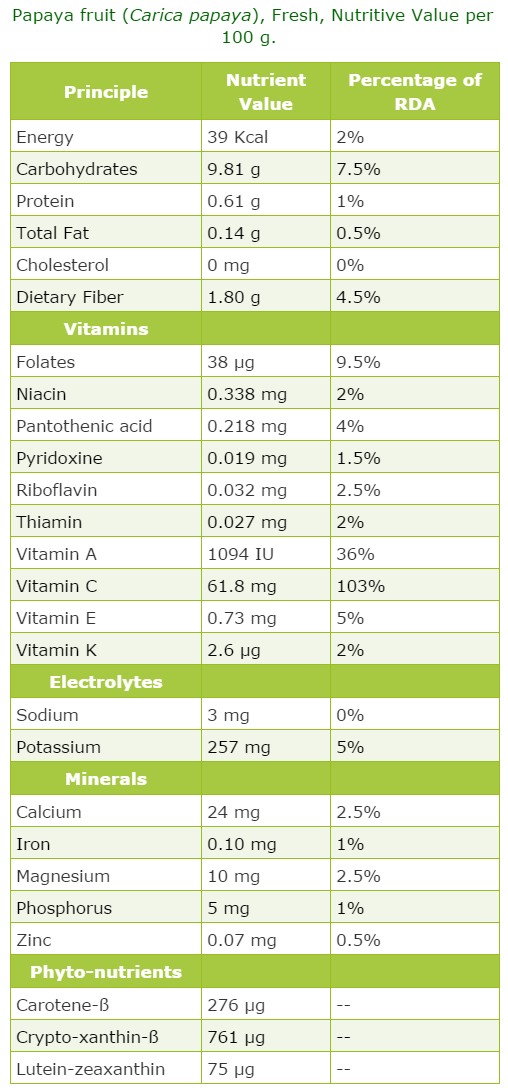
(Source: USDA National Nutrient database)
For people who drink several glasses of orange juice each morning for your daily intake of vitamin C, you may want to think again.
One serving of papaya can actually provide you with all the vitamin C you need for one day; in fact, that one serving contains nearly 300% of the recommended daily amount of vitamin C (3)!
So, just one serving of papaya has essentially the same amount of vitamin C, if not more, as all those glasses of orange juice.
Two of the most beneficial compounds in papayas are chymopapain and papain.
Chymopapain is a proteolytic enzyme that is extracted from the latex of the papaya.
Its most common use involves relieving pain caused by herniated disks in the spine.
Injecting the compound directly into the disk dissolves parts of the disks, thereby relieving the pain and pressure of the disk on surrounding nerves (5).
Papain is a digestive enzyme that is important for breaking down tough, fibrous proteins often encountered when consuming meats.
Health Benefits of Papaya
High in Carotenoids
The role of carotenoids in human health has been studied for a long time.
Dietary carotenoids are believed to be important in decreasing the risk for diseases, especially cancers and eye problems.
The carotenoids that have been researched the most include beta-carotene, lycopene, and lutein.
In fact, for a long time, it was thought that the primary sources of beta-carotene and lycopene were tomatoes and tomato products (7).
Recently, however, random control trials have discovered that these main carotenoids are more bioavailable from the papaya than from either carrots or tomatoes.
In fact, the bioavailability of beta-carotene from papayas is nearly three times higher than that from tomatoes or carrots.
Beta-carotene is a vitamin A precursor, an extremely important vitamin necessary to the human diet.
The other carotenoids, such as lycopene, are not converted into vitamins but instead have been reported to decrease the risk of cardiovascular disease and many cancers (8).
With that being said, it is clear that carotenoids and therefore the papayas that provide such pigments are quite beneficial for your overall health.
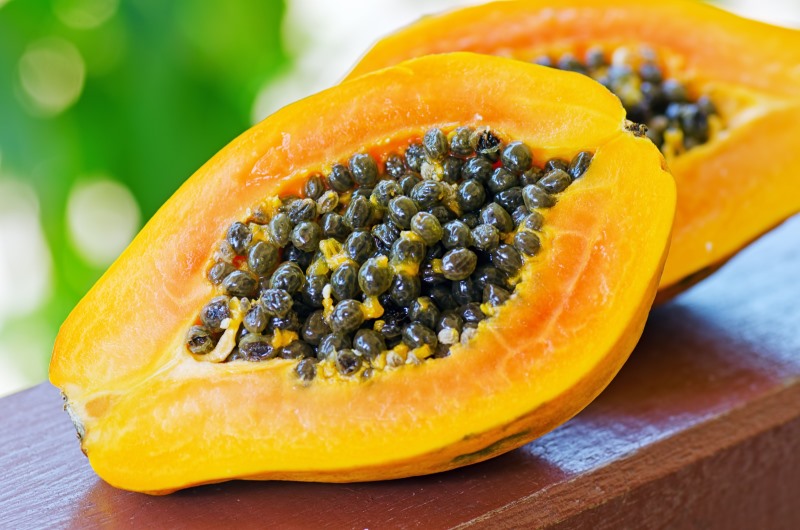
Neutralizes Free Radicals and Reduces Oxidative Stress
Free radicals are reactive chemical species with a single unpaired electron, making them highly unstable and dangerous to biological systems by causing oxidative stress on organisms.
Luckily, the human body deals with these potential dangers through its natural endogenous, antioxidant systems.
The consumption of antioxidants and other factors provide protection against these free radicals, but if the generation of free radicals from naturally occurring cellular respiration exceeds the protective effects from antioxidants, oxidative damage can occur.
Many scientists believe that this oxidative damage has a key role in general aging as well as cardiovascular disease and neurodegenerative disorders (9).
Fortunately, researchers have begun to discover that fermented papayas not only provide a sufficient helping of antioxidants to strengthen the body’s antioxidant defense system but may also be able to neutralize the free radicals.
The compounds in papaya essentially render those harmful chemicals useless so that they can no longer harm the body.
Further studies are still planned, though, since it seems that fermented papayas need to be consumed each day to most efficiently strengthen your defense system (10).
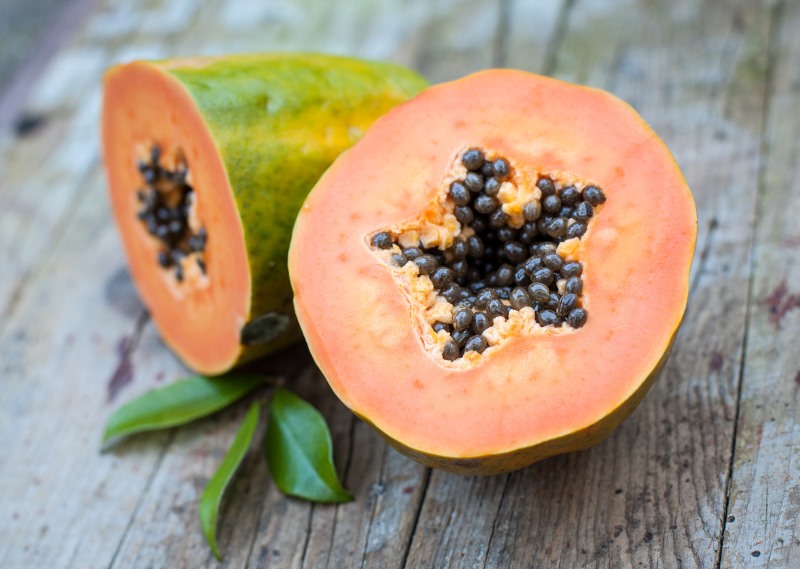
Lowers the Risk of Alzheimer’s
Alzheimer’s disease (AD) is the most common neurodegenerative disease as well as the primary cause of dementia in the elderly.
It has been determined that there is no single cause of Alzheimer’s, but instead, the disease is initiated by a complicated array of factors.
One of these is oxidative stress, which, along with its many other effects, has been thought to cause amyloid-beta and tau-induced neurotoxicity, both of which are primary hallmarks of Alzheimer’s disease (11).
Unfortunately, brain tissue is especially susceptible to oxidative stress, which highly validates the importance of keeping your brain healthy to reduce the risk for such neurodegenerative disease as Alzheimer’s.
In this particular disease, one of the many biomarkers that scientists use for diagnostics is called 8-OHdG.
In one study, researchers measured this biomarker to be much higher in Alzheimer’s patients compared with controls.
What is interesting, however, is that when these same AD patients were supplemented with fermented papaya, the papaya extracts significantly decreased the amount of 8-OHdG over a 6-month period.
The reasoning behind this treatment is that compounds in papaya can counteract the effects that free radicals and oxidative stress have on the body and, more importantly, the brain (12).
Reduces Cancer Risk
As mentioned previously, lycopene, like that in papayas, is a type of carotenoid, like beta-carotene; however, lycopene is not a precursor for vitamin A but instead is an intermediate in the biosynthesis of other carotenoids and has incredibly strong antioxidant properties.
What is more interesting is its amazing anticancer properties.
Antioxidants protect our bodies from oxidative stress, which is an important factor in how we age.
Studies are also beginning to discover that the antioxidant protection, especially from lycopene, also protects us against oxidative damage to our DNA that could activate oncogenes, or cancer-causing genes.
Dietary antioxidants from carotenoids like lycopene may be able to protect our cells from damage caused by internal or external sources, such as radiation (13).
Once again, the main point to remember is that oxidative stress, when in combination with high levels of insulin and glucose, poses a major risk of cancer, especially for people with diabetes.
Nevertheless, researchers believe that fermented papaya preparation (FPP) can influence signaling cascades associated with uncontrolled cell growth and survival, thereby making it a possible therapeutic method for patients already undergoing cancer therapies (14).
Prevents Heart Disease
High-density lipoproteins (HDL) are the good kind of lipid.
They are associated with a reduced risk of cardiovascular disease (CVD), they stimulate glucose uptake, and oppose insulin resistance.
Patients with type 2 diabetes, however, are thought to have malfunctioning HDLs, making them more prone to CVD.
In a randomized control trial of eighty obese patients, the subjects increased their fruit and vegetable intake, which resulted in carotenoid content and enhanced the cardioprotective properties of HDLs.
Since scientists have many evidence-based reviews that support the beneficial effects of carotenoids and the papaya’s extremely large supply of these carotenoids, it is clear that consuming larger amounts of papaya would effectively lower one’s risk for heart disease (15).
Even for people without type 2 diabetes, the ratio between low-density lipoproteins and high-density lipoproteins is a precarious balance—too little HDLs means a higher risk for CVD whether or not you have diabetes.
Therefore, anyone can benefit from increased intake of not only papayas but also from many similar fruits and vegetables.
Reduces Inflammatory Markers
Both chronic and low-grade inflammations are common causes and/or triggers for many diseases, such as obesity, diabetes, insulin resistance, and other metabolic disorders.
Low-grade inflammation specifically is a common characteristic of obesity.
For people who suffer from obesity, scientists have found more circulating inflammatory markers in their blood compared with leaner people; following weight loss; however, those amounts of markers decrease, therefore demonstrating a positive relationship between weight and inflammatory marker amounts (16).
Because of their abundance of antioxidants and flavonoids, papayas have been found to dampen inflammation by affecting T cells, which mediate the inflammatory response.
Indeed, researchers conducted a study where male subjects were given prepared papayas to consume, and scientists observed how a number of regulatory T cells changed after consumption.
They discovered that inflammatory cytokines were significantly repressed and that the papaya may directly exert an anti-inflammatory response through the use of those regulatory T cells (17).
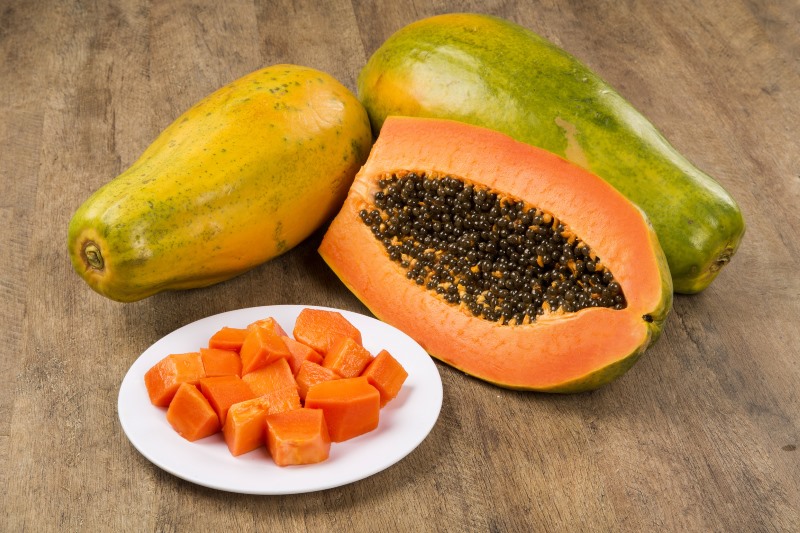
Improves Digestion
Aside from their abundance of carotenoids and antioxidants, an additional hallmark of papayas is that they contain an enzyme called papain.
More specifically, papain is actually a proteolytic enzyme, which means that it aids in protein digestion, and it is normally extracted from the latex of unripe papayas.
Several researchers believe that this special enzyme is responsible for the papaya’s renowned digestive properties.
Many cultures use papayas as natural remedies for abnormal digestive problems, such as constipation, heartburn, and symptoms of irritable bowel syndrome.
In one double-blind, placebo-controlled study, the effects of papaya preparation Caricol® on improving digestive symptoms were observed.
Researchers concluded that papaya preparation contributes to the maintenance of the digestive tract by, most significantly, relieving constipation, bloating, and symptoms of irritable bowel syndrome (18).
An additional study conducted at the University of Illinois at Urbana-Champaign suggested that papayas could actually act as a digestive aid since the papain in papayas helps to displace meat boluses and are a great source of fermentable substances beneficial to your overall health.
Can Treat Ulcers
Although the meat of the papaya is the most notable part of the fruit used for its health benefits, the seeds, leaves, and roots of the papaya plant are also very helpful in treating certain conditions.
Specifically, the extract from papaya seeds has been recognized to have both gastroprotective effects and antiulcerogenic activity.
A study was conducted to evaluate this claim, using models of acute gastric ulcer induction and chronic ulcers in rats.
When given in high doses compared with the rat’s weight, the papaya seed extract significantly reduced both gastric lesions and ulcerative symptoms (20).
In West Africa, especially, ulcers are unfortunately very common, and it is highly important to discover ways to treat such diseases with natural remedies, such as the papaya.
The Buruli ulcer (BU) is the third most common mycobacterial infection in the world, just after tuberculosis and leprosy.
A large systematic review was compiled, listing several plants and compounds with anti-BU properties, and the papaya remains as one of the better-known plants that have demonstrated efficacy in treating hospitalized BU patients (21).
Discovering a convenient and less expensive approach, such as the use of the papaya, in treating these types of patients in less developed countries is a beneficial step in the right direction.
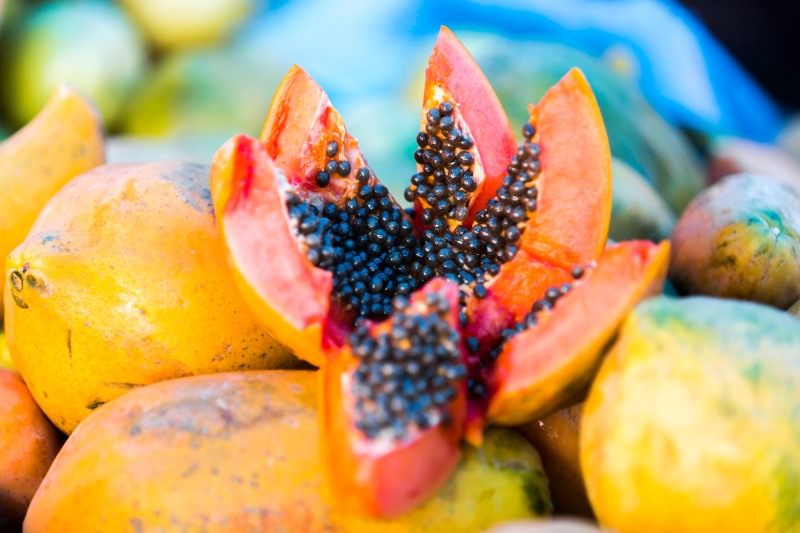
Helps Anti-aging
Not surprisingly, the rate of skin aging is predominantly determined by the rate of tissue degeneration over the rate of tissue regeneration.
Nevertheless, skin aging does indeed also depend greatly on your genetic makeup and lifestyle.
Excessive free radicals are believed to affect wrinkling, sagging, and other skin damage that occurs while aging.
Fortunately, lycopene and vitamin C—components that have already been mentioned as being numerous in papayas—have properties that protect your skin from the signs of aging.
One of the most important extrinsic aging factors involves photo-aging, or how UV exposure affects the skin and contributes to skin sagging, wrinkling, and degenerating.
The nutrients packed in papayas act like a natural “sunscreen,” protecting the skin from harmful rays and therefore also preventing premature wrinkling (22).
Treats Dengue Fever
Dengue fever is a disease that affects anywhere from 50 to 270 million people each year in over 125 different countries.
It is a viral disease that is transmitted by the bite of the Aedas mosquito, making it very similar to malaria and also just as lethal.
The symptoms of this disease include fever, hemorrhaging, and occasionally encephalitis and myocarditis.
Since little is known about the disease, treatment is usually symptomatic, meaning that doctors can only treat the symptoms as they occur.
Unfortunately, there is no known effective antiviral agent to treat dengue fever.
Papayas, however, offer a hallmark treatment for this disease.
Studies have shown that the papaya plant can be used to treat the deficiency of platelets in the blood that is a universal symptom of dengue fever.
Scientists believe that the extract from the leaves of the papaya plant contain membrane-stabilizing properties and can protect the blood against stress-induced destruction, which is crucial for treating the symptoms that occur with dengue fever.
Only a few studies involving humans have been conducted, but many of the recorded outcomes of treating human patients suffering from dengue fever with papaya have had good outcomes.
Many cases resulted in increased platelet and white blood cell counts, greatly alleviating the symptoms of the disease in these patients (24).
Treats Skin Wounds
Burns are one of the most common skin wounds, but because of limited resources in such areas as Africa and other less developed countries, managing burns becomes a serious endeavor.
Traditional medicine is necessary to save lives and money.
One of the traditional therapies for dressing burns and wound healing involves papaya, which constitutes the major component of their burn dressings.
Papayas are actually currently used in the pediatric unit at the Royal Victoria Hospital in Banjul, the Gambia since it is well tolerated by the children there.
To prepare the papaya, the pulp is extracted from the ripe fruit, and then it is mashed and applied to infected burns.
Scientists believe that the efficacy of the papaya as a wound healing treatment arises from papaya’s proteolytic enzymes, chymopapain and papain, and also from its antimicrobial activity (25).
Amazingly, in a randomized study comparing papaya dressings to hydrogen peroxide dressings, papaya dressings resulted in a shorter time needed for the development of healthy granulation tissue and a shorter hospitalization stay for the patients, despite hydrogen peroxide dressings being the current mode of dressings for most hospitals (26).
It is quite possible that Africa has the right idea when it comes to using traditional medicine for treating skin wounds and burns.
Treats Acne
One of the lesser known benefits of papaya is that papain can actually help to reduce acne and pimples, which is an increasingly expensive and prominent area of treatment.
In one particular study, an ointment consisting of a combination of papain and several other compounds was tested on patients to evaluate its ability to reduce the incidence and severity of mild to moderate acne.
The sample size consisted of ninety-eight Caucasian patients ranging in age from fifteen to forty years old, and each patient was treated with the ointment once a day for twelve weeks.
After the study had ended, researchers evaluated the efficacy of the treatment using a universal Global Acne Grading Scale (GAGS), and lesions count to determine if the treatment was beneficial or not.
Fortunately, what researchers discovered was that there was a 41% mean reduction in the observed GAGS score as well as a decreased lesions count after the treatment period (27).
Since papain is an enzyme-dissolving protein, which means that it effectively dissolves fat, cleanses the skin, and allows your pores to remain unclogged, such treatment leads to a lesser likelihood of acne and pimple outbreaks.
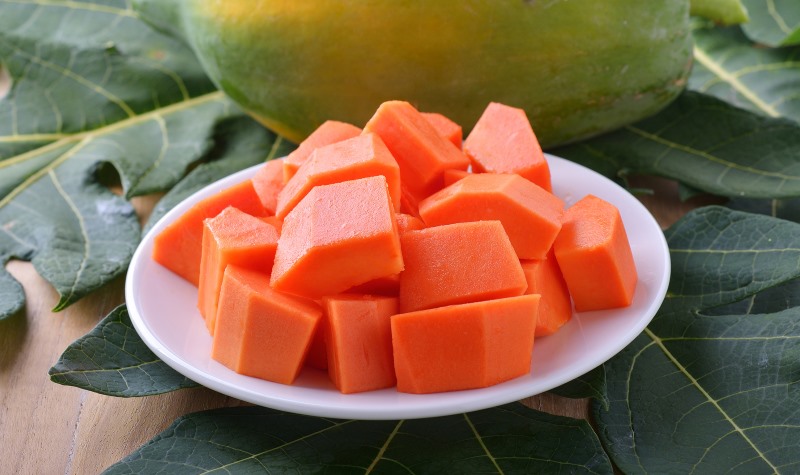
Eliminates Parasites
Papayas, more specifically papaya seeds, are actually highly efficient at expelling worms and parasites.
The reason for this uncanny ability lies in a substance called caracin, which is quite abundant in papaya seeds, and is known for its effectiveness in ridding organisms of roundworms.
An additional compound, alkaloid carpaine, also found in the seeds of this versatile fruit, can also destroy and expel intestinal worms.
Researchers in Mexico wanted to test these ideas by comparing extract from papaya seeds with control groups to determine their ability to reduce numbers of parasites.
Scientists found that the animal subjects treated with papaya seed extract had a significant reduction in particular parasites from both parasitic stages.
Such conclusions clearly need more testing to be definitive, but many credible sources have shown that the fatty acids found in papaya seeds can significantly decrease the number of parasites in both intracellular and extracellular methods (28).
Antidiabetic Benefits
Sadly, statistics show that nearly one-third of the United States population is obese, while another one-third is overweight.
Aside from all the other reasons why excess weight is unhealthy for you, being obese or even overweight puts you at a much higher risk of developing diabetes.
Since one-third of our population is suspected to be obese, it is no wonder why close to 10% of the population does, indeed, have either form of diabetes (29).
For diabetics, controlling your insulin is a necessary part of your day, but, sadly, many people suffering from this disease do not adequately take care of themselves or their glucose levels.
With this growing pandemic, it is vital for us to lead healthier lives to prevent these types of health problems.
Treatment, as well as prevention, should also be investigated.
As a commonly used plant for traditional medicine, the papaya has been known to produce hypoglycemic effects and improve lipids profiles in both animal and human subjects.
When aqueous papaya extract was administered to diabetes-induced rats, researchers noticed that the extract decreased blood glucose levels and cholesterol while only slightly decreasing the animals’ weights.
Other observations included positive effects on both the integrity and function of the liver and pancreas, which are promising findings toward helping manage this unfortunate disease (30).
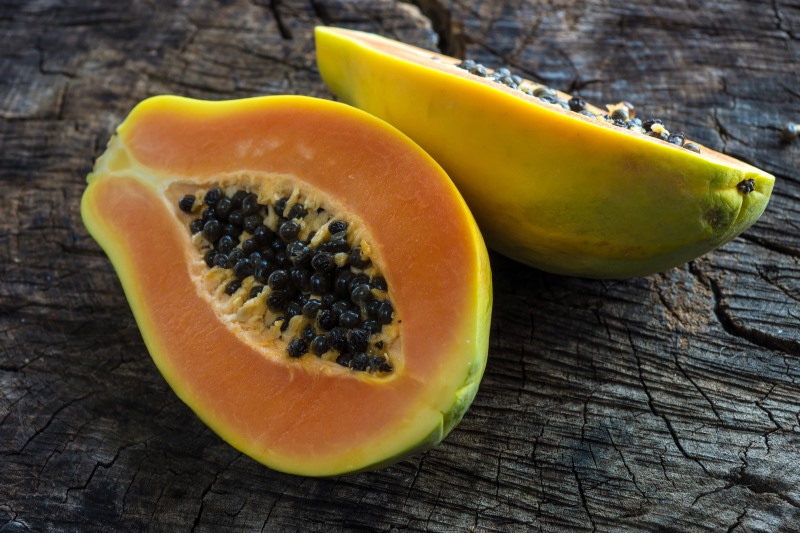
Reduces Arthritis Pain
Rheumatoid arthritis (RA) is a complex disease that shares many of the same inflammatory and immunological responses as cardiovascular disease.
The similarities begin with increased production of free radicals—the culprit for many of our current global health problems.
The products of these free radicals have been identified in the fluid of inflamed rheumatoid joints, suggesting that inflammation is indeed mediated by free radical activity.
Exogenous antioxidants are important in scavenging these oxidative agents and thereby preventing oxidative damage (31).
Similarly, the papain in papayas also increases the production of immune cells called cytokines.
Cytokines are actually able to speed healing and reduce the speed of blood clotting mechanisms to improve circulation and deliver precious nutrients to inflamed areas of the body, such as arthritis-stricken joints.
Many people also believe that papayas are natural pain killers and swear by their pain relief properties, although further testing and research must be done to prove such a theory.
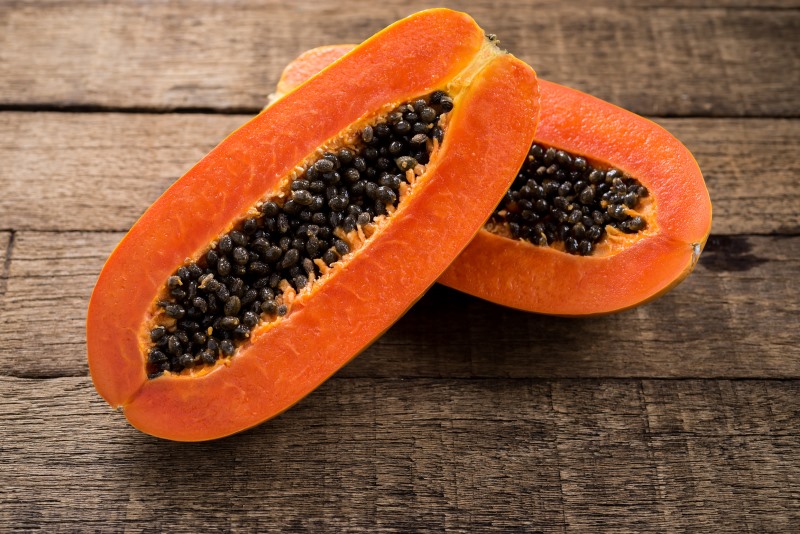
Prevents Macular Degeneration
Age-related macular degeneration is the primary cause of vision loss in older adults.
The papaya’s nutritional profile demonstrates that this fruit is a great source of vitamin A, vitamin C, and vitamin E, which are all vitamins that help promote healthy eyes.
In fact, a study in the Archives of Ophthalmology found that eating at least three servings of fruits, including papayas, per day can actually lower your risk for age-related macular degeneration (ARMD).
What’s more is that simply eating this recommended amount of fruit reduces your risk by 36% compared with people who eat less than 1.5 daily servings of fruit, likely because the antioxidants in fruits like papaya can repair the macular degeneration when it is occurring.
Interestingly, although vegetables also include several antioxidants and carotenoids, they were not shown to have any protective factors against ARMD or a more severe version of ARMD, which is neovascular ARMD, whereas fruits had a very significant effect.
Additionally, fresh yellow- or orange-colored fruit, like papayas specifically, can also aid in preventing other eyes diseases as well, such as glaucoma and cataracts, because of, once again, the papaya’s natural supply of carotenoids and antioxidants (33).
Promotes Lung Health
Similar to the way they help prevent macular degeneration, papayas also promote lung health due to their vitamin A content.
Research conducted at Kansas State University suggests a relationship between vitamin A deficiency, lung inflammation, and emphysema.
These findings are important for people who smoke and even for those who do not but are exposed to secondhand smoke because a common carcinogen in cigarette smoke, benzo (a) pyrene, is actually thought to induce vitamin A deficiency.
For smokers and those exposed to secondhand smoke who have significant vitamin A deficiencies along with poor diets, there is a high risk that such an unhealthy combination will lead to emphysema and/or cancer.
Some researchers believe that this may explain why some smokers live to be a hundred years old while others die prematurely.
Those who begin smoking at an early age will likely develop vitamin A deficiency early on and the complications associated with that if they do not protect themselves by countering the effects of a diet rich in vitamin A (33).
Papayas are a fantastic source of vitamin A, so for those who turn to cigarettes or are required to be in environments where you are exposed to secondhand smoke, it would be highly beneficial to protect yourself from the harmful effects by consciously including papayas and other vitamin-rich foods in your daily diet.
Anti-sickling Properties
Sickle cell anemia is a genetically inherited disease that causes an individual to have an abnormal beta-globulin gene, thereby causing their red blood cells to form into biconcave disc shapes rather than the normal disc-shape erythrocytes.
Because of the shape change, the sickled red blood cells are less soluble and cannot move through the bloodstream as easily, making it more likely that they will clog blood vessels.
If this occurs, the oxygen-carrying erythrocytes cannot reach their destinations because of the clog, and the tissues and organs, therefore, will not receive the oxygen they need to live and thrive.
Fortunately, the dried leaves, as well as the extract from papayas could well be a way to manage this disease.
Research and many experiments suggest that the plant extract can reduce the reduction and destruction of red blood cells as well as protect the erythrocyte membranes.
Doing so may inhibit the formation of sickle cells under certain conditions, indicating the possible efficacy of using papayas as candidates for sickle cell anemia therapy. On the other hand, dried papaya leaves also present possible therapeutic use.
One particular experiment tested and compared numerous concentrations of leaf extract and found that all concentrations inhibited the formation of sickle cells to some degree, with the concentration 10mg/mL having the highest anti-sickling effect.
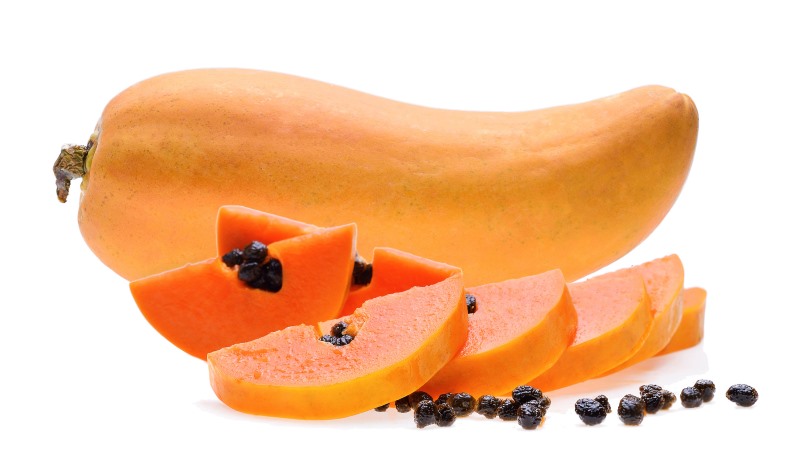
Protects Skin from Sun Damage
Everyone goes outside, but not everyone remembers to wear sunscreen.
UV rays from the sun can be incredibly harmful to people who do not protect themselves adequately when out in the sun and can put you at risk of skin cancers and early signs of skin aging.
Fortunately, the micronutrients found abundantly in papayas, carotenoids, and flavonoids, provide systematic photoprotection from the sun’s harmful rays and have also been found to prevent UV-induced erythema, which is the reddening of the skin noticeable after being out in the sun for too long.
In one particular study, participants were subjected to ten to twelve weeks of intervention involving the ingestion of lycopene or products rich in lycopene, such as papayas.
After the intervention period, researchers measured a decrease in the sensitivity toward UV-induced erythema, displaying how dietary carotenoids may contribute to long-term skin protection from the sun (23).
In other words, the real trick to protecting your skin is to work from the inside out by eating more carotenoid-rich foods!
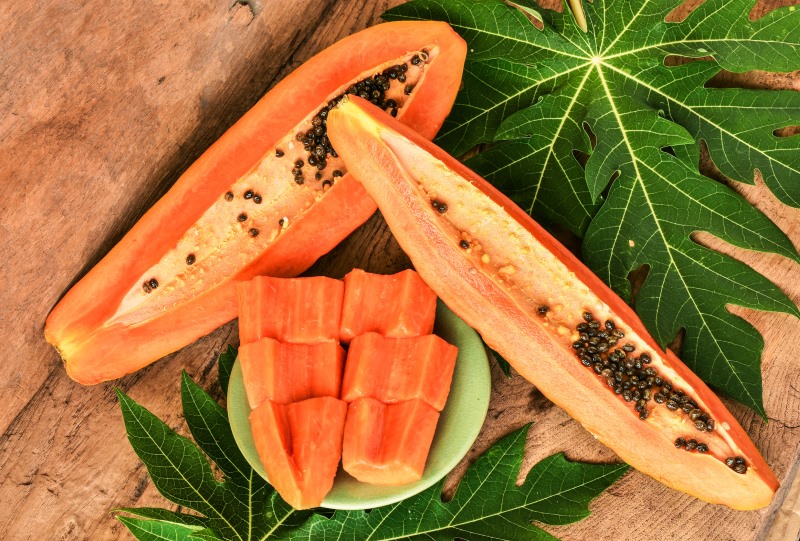
Treats Polio
It has long been debated whether or not vitamin C can actually help enhance resistance to the poliomyelitis infection.
Polio is a highly infectious disease with symptoms varying from respiratory illness, influenza-like symptoms and, most notably, paralysis.
The disease is exclusive to humans and transmitted through the fecal-oral route.
The early to mid-1900s was a period for much alarm, as the paralytic polio epidemic struck the United States.
Fortunately, a polio vaccine was introduced in the 1950s, which eradicated the disease from the United States.
To this day, however, many citizens in lower developed countries still battle the disease and/or the risk of outbreaks.
In the 1930s and ’40s, much work was devoted to finding cures and treatments for polio, one such cure simply being vitamin C.
Several experiments involving monkeys showed that several doses of paralytic poliovirus were rendered noninfectious when mixed with small doses of ascorbic acid, or vitamin C.
Although many experiments had varied success rates in vitro and in animal subjects, very few experiments involved humans, forcing a need for ongoing research on the topic (35).
Therefore, it is not to say that eating foods rich in vitamin C, such as papayas, will suddenly cure you of polio, but the vitamins provided by such fruit are extremely beneficial in more than one respect and maybe a future therapeutic option for patients stricken with the disease.
Prevents Scurvy
Most commonly known since its discovery in nutrient-deficient mariners in the fifteenth and sixteenth centuries, scurvy is a disease that can result in devastating health benefits without proper treatment.
Humans are unable to synthesize ascorbic acid, which means that we need to obtain the recommended daily amount of this vitamin to maintain our body’s proper functioning and, most notably, absorb iron from the intestinal tract.
Scurvy is a disease in which a person simply does not have enough vitamin C in their system, which therefore causes lethargy, fatigue, anemia, and many more symptoms.
The longer you go without proper doses of vitamin C, the more life-threatening the symptoms become, which include such things as edema, jaundice, neuropathy, and death (36).
Luckily, scurvy is a very preventable disease.
Simply by monitoring your own intake of vitamin C can help prevent this disastrous disease.
Incorporating vitamin-rich foods, such as oranges, papayas, and limes, into your daily diet can help ensure that you are getting enough vitamin C.
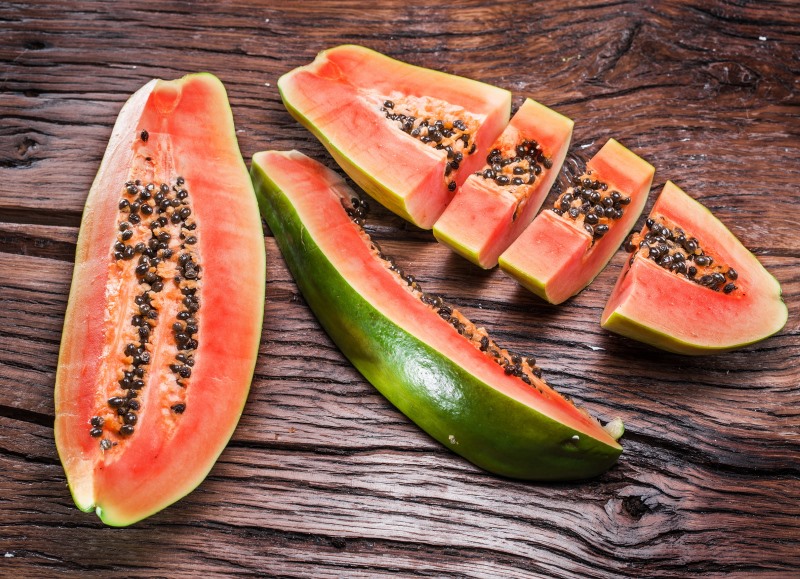
Treats Certain Types of Anemia
Another beneficial nutrient found in papaya is from the vitamin B family.
It is water soluble and helps make and maintain red blood cells.
If you do not get enough folic acid per day, you are likely at risk for anemia, more specifically, folic-acid-deficiency anemia.
Those who suffer from anemia most commonly have shortness of breath, dizziness, headaches, and, most commonly, fatigue.
People who are anemic feel as if they have very little energy and are tired all the time, which occurs because your heart must work harder to pump oxygenated blood throughout your body, since red blood cells are not being produced as efficiently.
Because there are many different types of anemia, it is best to consult a physician to determine your specific type, but once you know, anemia can be managed fairly easily.
Papayas, as we know, contain lots of vitamin C, but they also contain substantial amounts of folic acid and also a generous portion of iron (37).
Consuming papayas can, therefore, help relieve some of the symptoms of anemia simply due to its abundance of vital nutrients.
Lowers Risk for Neural Tube Defects in Fetuses
Folate is an essential nutrient required for DNA replication and general cell synthesis.
Although it is an important nutrient for any healthy person, it is especially vital for pregnant women and their fetuses.
Folate deficiency has long been proven to be correlated with abnormalities in mothers, such as anemia and neuropathy, and congenital abnormalities in fetuses, such as spina bifida and anencephaly.
Spina bifida is a devastating spinal cord abnormality in which a portion of the spinal cord does not form properly and is usually present outside the body.
While it is possible to live with this disorder, anencephaly, on the other hand, is always fatal since the fetus is born lacking the telencephalon portion of their brain.
Fortunately, these defects, along with others, are almost entirely preventable simply by consuming the recommended amount of folic acid during pregnancy, which is currently about 600 µg (38).
Papayas and other citrus fruits are incredibly high in folic acid, so if you find it unfavorable to take folate supplements every day, simply find ways to incorporate papayas into your diet while pregnant!

Reduces Risk for Stroke
We are familiar with how to recognize strokes—loss of feeling in your limbs, blurred vision, slurred speech, paralysis on one side of the body.
What we don’t know as well as how to prevent a stroke, which occurs when plaque buildup in the arteries blocks the blood flow to the brain.
This can have a devastating impact. One common cause of strokes is high cholesterol — when there are high levels of cholesterol, plaque can form and cause artery blockage, preventing blood flow.
Many studies have inconsistent findings, but one that seems to be universal is that lowering cholesterol, especially bad LDL cholesterol, reduces the risk of stroke in high-risk populations (39).
There are numerous proposed ways to reduce cholesterol, but some more recent findings suggest that the nutrient lycopene actually has an effect on reducing LDL cholesterol, thereby also reducing your risk for stroke.
One meta-analysis discovered that when taken in doses of more than 25 mg daily, lycopene can decrease LDL cholesterol by about 10% (40).
If you do nothing else, at least add lycopene-rich papayas to your diet to help reduce your risk for strokes in the future.
Relieves Whooping Cough
Whooping cough is a universal disease that seems to target mainly preschool and school-aged children.
Although a large percentage of children who are vaccinated for whooping cough does not get the virus, there is still a noticeable percentage who do contract it.
Because vitamin C has been known to have detoxifying effects, many cases and experiments have been analyzed to see if vitamin C can treat whooping cough.
Such experiments have had mixed conclusions, and no definite answers can be ascertained, but high doses of vitamin C have been shown to relieve the harsh symptoms of the virus.
What’s more is that it has shortened the period of severe illness from several weeks to several days, suggesting that this vitamin actually does more than just relieve the uncomfortable symptoms—that it does actually help to eliminate the virus in some way (41).
Because whooping cough is especially fatal for young children, it is important for both you and your children to get lots of vitamin C daily from such foods as papayas and other citrus fruits.
Ways to Buy and Store
Although many people consider papayas to be tropical and exotic fruit, they have become so universal that they are now readily available around the world.
With a wonderfully soft, butter-like consistency and a deliciously sweet, yet musky taste, papayas have seen a sharp rise in popularity recently and hopefully will see an even greater rise once people catch on to its amazing health benefits.
For those of you who are eager to enjoy your fruit within a day of purchase, be sure to choose papayas with reddish or orange skin and which are slightly soft when you touch them.
Papayas with yellow patches on their skin are still slightly unripe and will take a few days to ripen fully.
Papayas that are completely green and very firm are very rarely used for eating, but they can be used for cooking since their sweet flavor is not yet developed.
If you purchase slightly yellow papaya but want to speed up the ripening process to enjoy it quickly, placing the fruit along with a banana inside a brown paper bag will allow the fruit to ripen in a day or two.
As for storage, ripe papayas should always be stored in the refrigerator and, if possible, should be consumed within about two days so that you can enjoy the maximum flavor of the ripened fruit!

How to Incorporate More Papaya into Your Diet
The best feature of papayas is that they are undeniably versatile.
They can be incorporated into your breakfast, lunch, snacks, or even for dessert!
Papaya Breakfast Recipes
For a fantastic and vitamin-rich breakfast, I suggest mixing some milk, Greek yogurt, vanilla extract, a frozen banana, and sliced, ripe papaya.
Blending all these ingredients together will give you an extremely hearty, easy, and super healthy breakfast that you can even pour into a travel cup to take your breakfast to work or on the road with you!
Or, if you want something even simpler, simply peeling, slicing, and seeding ripe papaya and eating the fruit raw with a bowl of yogurt can easily help you to incorporate your daily vitamin C recommendation into your diet.
Papaya Lunch Recipes
For lunch, a fresh bowl of fruit salad is a super easy way to get your daily dose of papayas.
First, peel and dice ripe papaya.
Mix it with an assortment of other fruits, for example, bananas, oranges, strawberries, and fresh berries.
Then toss everything with a dressing of light yogurt and a squeeze of lemon juice for a perfectly cool afternoon lunch for hot summer days.
Papaya Snack Recipes
If you are more of a “snacking” person who can’t find the time to sit down for a meal, try making a papaya salsa.
Ripe papaya pairs well with the smoky flavors of Mexican food and makes for a great base ingredient for spicy salsas.
One recipe you can try includes sliced raw papayas, diced pineapple, scallions, garlic, lime juice, salt, and black pepper.
Stirring all the ingredients together makes for a savory salsa dip for tortilla chips, or it can just as easily serve as a topping for warm, chicken quesadillas.
Papaya Dessert Recipes
Although it is not as commonly used as a dessert ingredient, papayas can act very similar to other fruits, such as peaches, bananas, or melons.
For a tasty dessert using slightly underripe papayas, try baking a loaf of papaya bread, similar to banana bread!
Shred a firm papaya and drain the excess moisture onto a paper towel.
Cream butter and sugar together, then add two eggs, one at a time.
In a separate bowl, mix the dry ingredients of flour, baking powder, baking soda, salt, cinnamon, allspice, and ginger.
Adding the dry ingredients into the butter-sugar mixture will create your bread “dough.”
After baking for approximately one hour, you will have yourself a deliciously warm loaf of papaya bread, which can be served with a drizzle of honey on top!
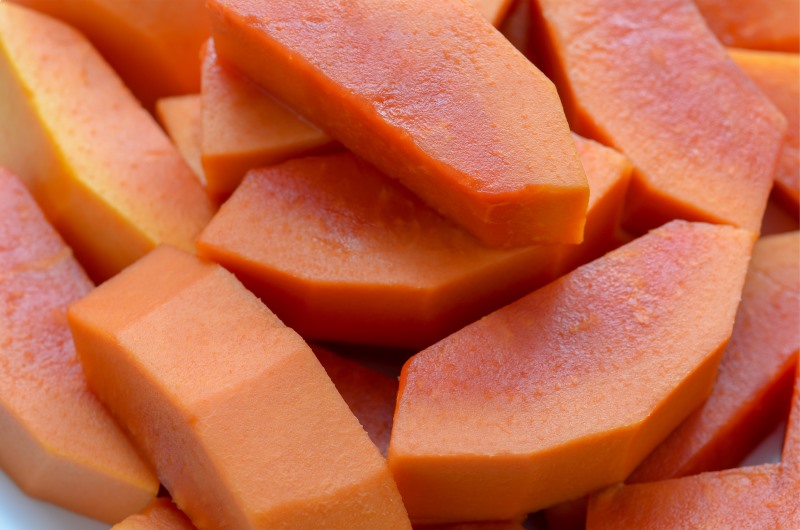
Precautions
Despite all the proven health benefits of papayas, there are still several concerns about eating too much papaya for certain groups of people.
One such group is pregnant women.
Studies have been conducted that show a positive correlation between the consumption of unripe or semi-ripe papayas and uterine contractions in pregnant women.
On the other hand, when in vivo studies were tested using rat subjects, fully ripe papayas did not produce the same effects.
This discrepancy is believed to occur because unripe and semi-ripe papayas contain latex, a compound that acts very similar to natural hormones, such as prostaglandin and oxytocin.
These hormones have long been thought to induce labor by inducing uterine contractions, but if these actions come at the wrong time, they may lead to miscarriages, abortions, or could be extremely dangerous for the growing fetus (43).
Although these studies have yet to be replicated to ensure their validity, it is recommended that pregnant women monitor their diets and err on the side of caution when trying to decide whether or not to consume unripe papayas.
Furthermore, as mentioned, papayas do contain compound latex.
If you know you are allergic to latex; it is very likely that you will also be allergic to papayas since they do contain this compound.
Eating papayas when you have a known latex allergy is likely to cause the normal allergic reaction you would have if you were in contact with the compound directly (42).
Conclusion
Overall, it should now be clear that despite its lack of public attention, papayas have many health benefits.
Not only does this fruit contain endless vitamins, antioxidants, and other nutrients, but it also offers a deliciously sweet taste that is hard to resist.
Its abundant nutrients have been found to protect against many diseases, such as cancer, cardiovascular disease, and inflammatory diseases.
For those also looking for natural ways to improve skin coloration, redness, and just wrinkles in general, the lycopene and vitamins in papayas promote the elimination of wrinkles and lead to smooth, sleek-looking skin.
The beauty of papayas is their ease of use and versatility.
Papayas can be incorporated into just about any meal, including large meals, desserts, and even midnight snacks.
This snack, fortunately, won’t leave you feeling guilty because indulging in the papaya’s hidden potential is something that should be shared with the world!
FDA Compliance
The information on this website has not been evaluated by the Food & Drug Administration or any other medical body. We do not aim to diagnose, treat, cure or prevent any illness or disease. Information is shared for educational purposes only. You must consult your doctor before acting on any content on this website, especially if you are pregnant, nursing, taking medication, or have a medical condition.
HOW WOULD YOU RATE THIS ARTICLE?
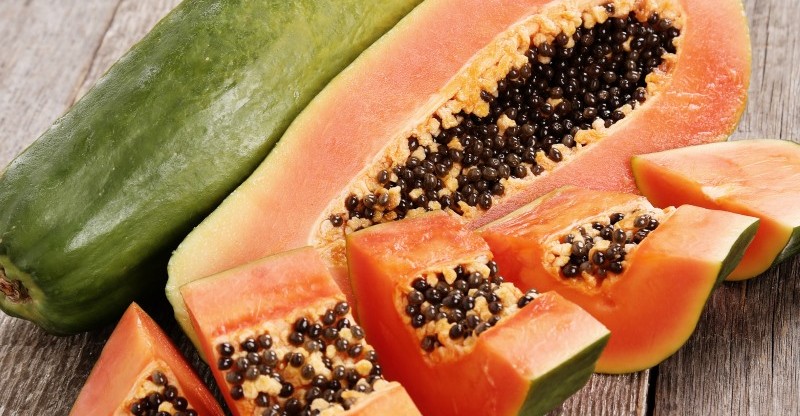


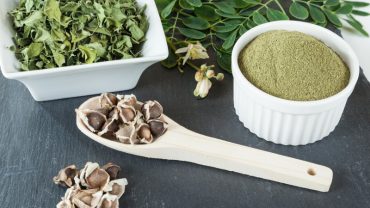
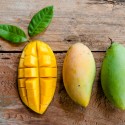


hi…how to choose the best papaya at the store??? I would like to pick the tastiest one…
Hi Christen! You should look for a firm yellow papaya with smooth skin. It’s recommended to buy green papayas to let them ripen at home – they become bright yellow.
One of the section claims that papaya can prevent neural tube defects but in precautions it is written that pregnant women should be careful with papaya…How much papaya can pregnant women eat safely?
Oh, so many benefits! I would like to know how I should use papaya to reduce acne. Should I eat it or apply on my pimples?
Is papaya grown in the US? How can I be sure that I buy non-gmo papaya in the supermarket?
Hello Helen Nichols,
A quick question for you is this article a part of a series of super fruits as i have read your article on mangoes as well and was wondering if you had a link. I am so fortunate to live in the Caribbean and grow both mangoes and papayas in my yard. I also grow Moringa as well and Aloe Vera too.
Thank you, kindly.
Thank you very much for the nutritional Info on papaya